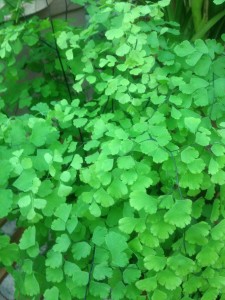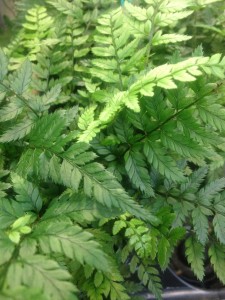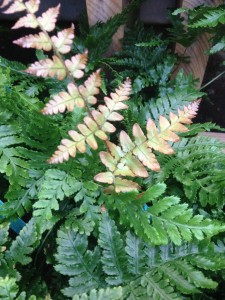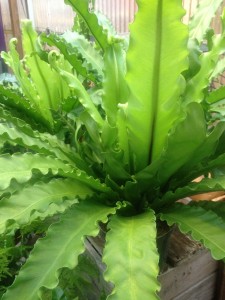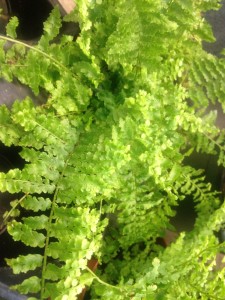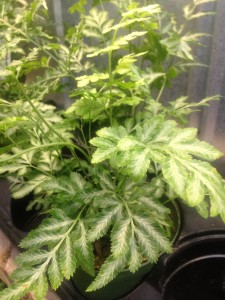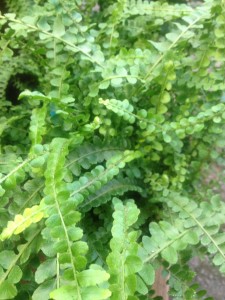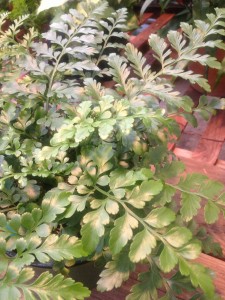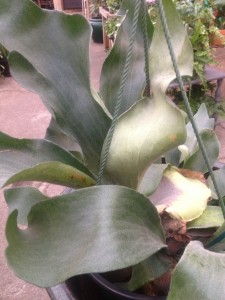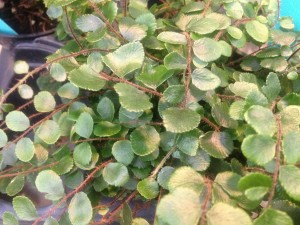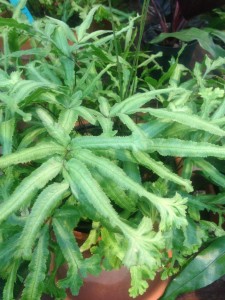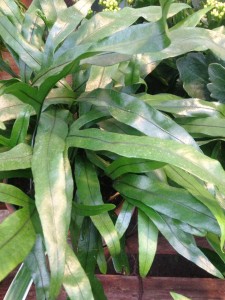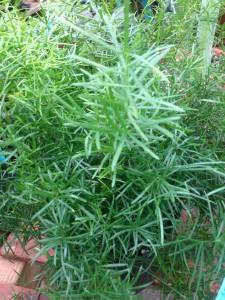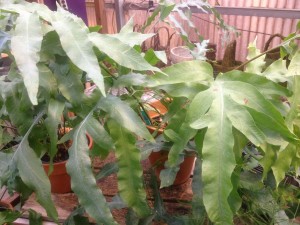When talking about plants, what’s in a name, anyway? Well, I’m glad I asked, because the plant you might have seen around town in every garden shop and grocery store that has the catchy name of “frosty fern” really isn’t a fern at all. I know most of you don’t really care much whether it’s a real fern or not, but, having grown up with my name being spelled wrong constantly (It’s Kris with a “K”, thank you very much.), I do get a little touchy about providing the correct plant name for folks that care about these things. I can just see how it all came about…some marketing guru somewhere said brightly, “I know!!! Let’s call it “Frosty” because it looks like the tips are frosted; and everyone will think it’s a fern, so let’s run with Frosty Fern!”
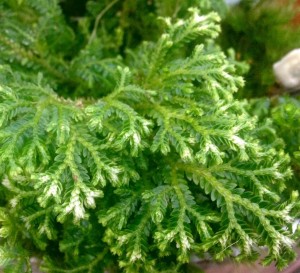
The tips of the leaves do look frosted…
To confuse matters even more, some knowledgeable plant people look at it and say, “Well, of course, it’s not a fern; that’s a spike moss, or club moss.” Now, actually, this is true, but in reality a “spike moss” isn’t a true moss either. Confused yet? Yeah, I thought you might be. Hang in there, though; it will all become clear, I promise.
Now is where we get to the good part…and the reason the plant marketers felt they had to dream up a catchier name. The correct name for this pretty little plant is Selaginella kraussiana, a name that almost rolls off the tongue…sellaahhginellaaahhh. What do you think? No? That’s what I thought. Okay, it’s enough for me that you are at least now aware that this plant is not a fern and not a moss. So let’s talk about what it is and how to take care of it.
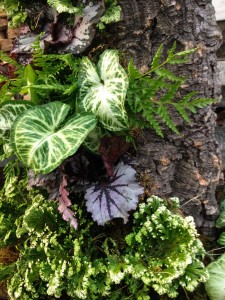
nephthytis, tooth brake fern, rex begonia and selaginella ‘Frosty’
This selaginella certainly could be mistaken for a fern, with its tiny leaves and wispy appearance. But, if you look closely, the leaves are flat and look forked. Which, I suppose, is also how it comes by its other common name, spike or club moss. The coloring of the leaf tips is natural; another selaginella, Selaginella uncinata, sometimes called peacock moss (Now it’s a moss; see how confusing this gets?), has beautiful iridescent blue-green leaves.
These plants are actually part of an interesting group of plants called fern-allies, not actually related to ferns but sharing the same reproductive means – spores.
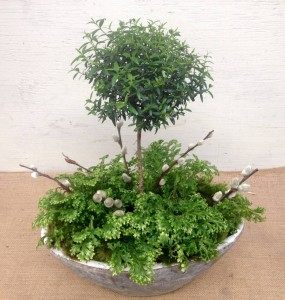
Selaginella ‘Frosty’ with a myrtle topiary
Selaginellas have become naturalized in parts of Portugal, Spain, and New Zealand, though they’re originally from Africa. They make quite wonderful terrarium plants since they’re happiest with good humidity and consistent moisture during the growing season. Like most plants, growth slows in fall and winter, so be sure to cut back on the water during those months and let them dry a bit between drinks.
Try to keep the humidity up as high as possible, especially if you plan on keeping one in your home through the winter months when your furnace is running and air gets drier. An easy way to do this is to place your selaginella on a shallow tray of pebbles filled with water just to the bottom of it. Sit your pot on the pebbles, taking care not to sink the pot in the water. As the water evaporates it will add moisture to the air around your plant.
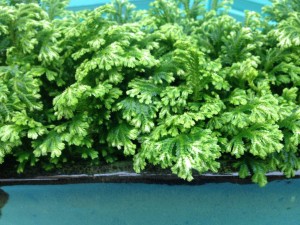 They prefer temperatures above 50 degrees, the perfect range being anywhere from 75 – 80 degrees F. If temperatures drop lower, the foliage can be prone to fungal problems and the tips of their tiny leaves will turn brown. So, if you are using them in outdoor shade planters through the summer, keep this in mind as the temperatures cool in the fall.
They prefer temperatures above 50 degrees, the perfect range being anywhere from 75 – 80 degrees F. If temperatures drop lower, the foliage can be prone to fungal problems and the tips of their tiny leaves will turn brown. So, if you are using them in outdoor shade planters through the summer, keep this in mind as the temperatures cool in the fall.
Bright but indirect light is best, either early morning or late afternoon if inside. Too much direct sun will cause the leaves to wilt and burn. Be careful not to over feed your selaginella, as too much fertilizer can also cause wilting and yellowing of leaves.
So, whatever you choose to call it, you now know its proper name (And don’t we all want to be called by our correct name?), and the marketing gurus haven’t got the last word after all!
By Kris Blevons
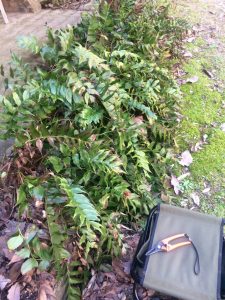
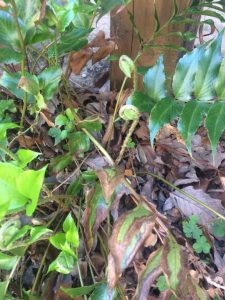 The holly ferns (Cyrtomium falcatum) I decided to clean up are in a protected spot at the edge of a patio area near the house, so they’d be easy to take care of in the event of a freeze. I brought out my folding garden seat and pair of small clippers and got to work.
The holly ferns (Cyrtomium falcatum) I decided to clean up are in a protected spot at the edge of a patio area near the house, so they’d be easy to take care of in the event of a freeze. I brought out my folding garden seat and pair of small clippers and got to work.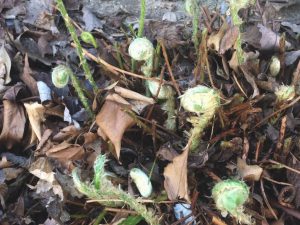

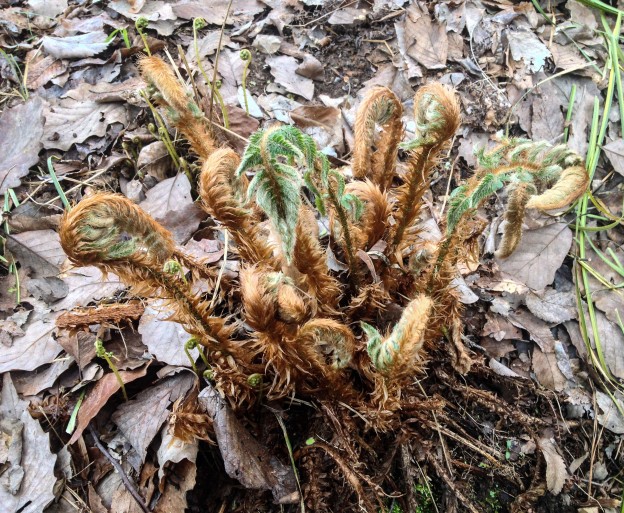
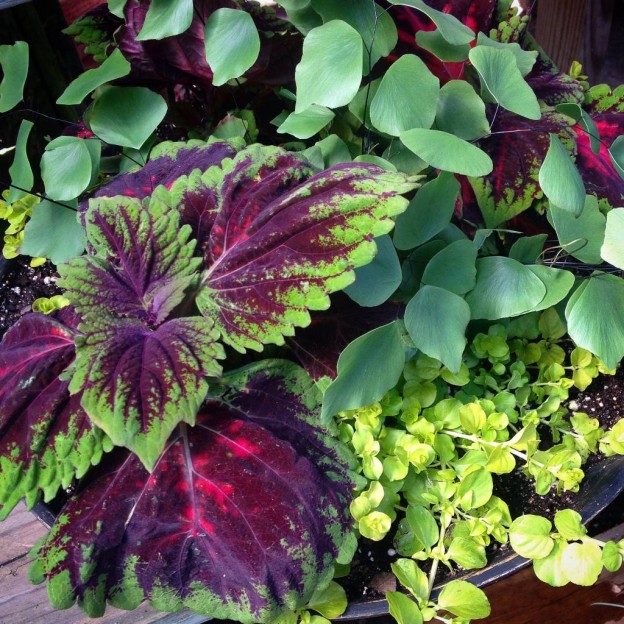
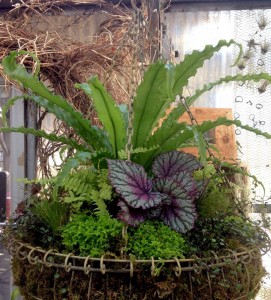
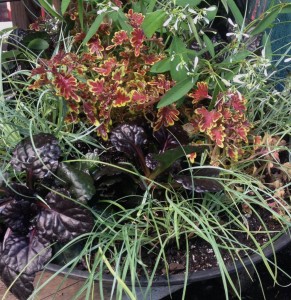
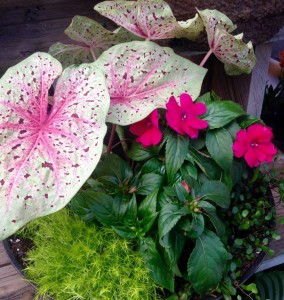
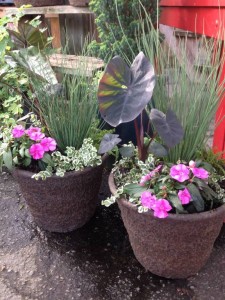
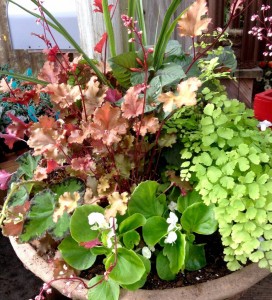
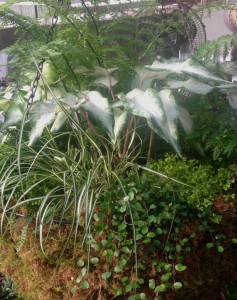
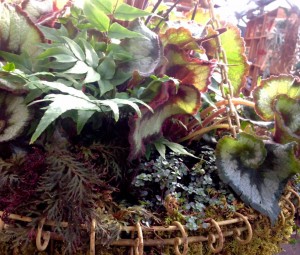
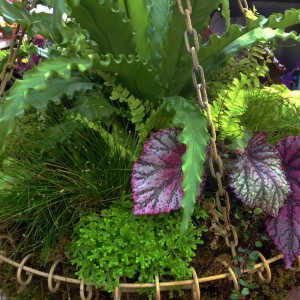
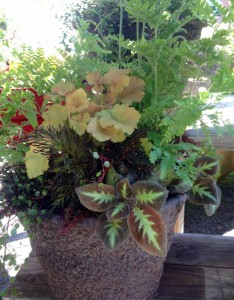
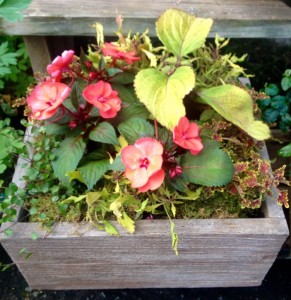




 They prefer temperatures above 50 degrees, the perfect range being anywhere from 75 – 80 degrees F. If temperatures drop lower, the foliage can be prone to fungal problems and the tips of their tiny leaves will turn brown. So, if you are using them in outdoor shade planters through the summer, keep this in mind as the temperatures cool in the fall.
They prefer temperatures above 50 degrees, the perfect range being anywhere from 75 – 80 degrees F. If temperatures drop lower, the foliage can be prone to fungal problems and the tips of their tiny leaves will turn brown. So, if you are using them in outdoor shade planters through the summer, keep this in mind as the temperatures cool in the fall.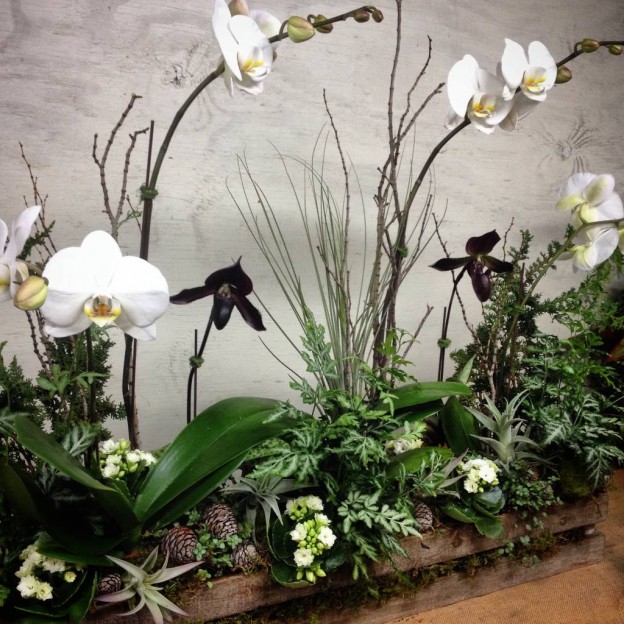
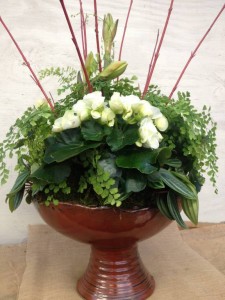
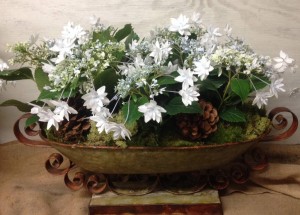
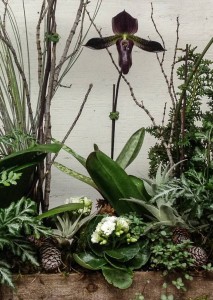
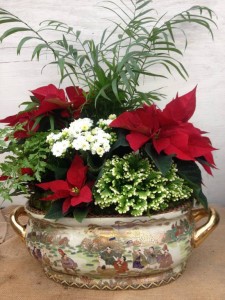
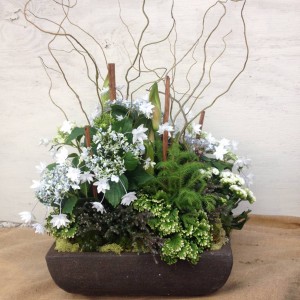
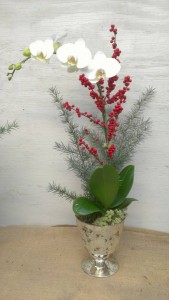
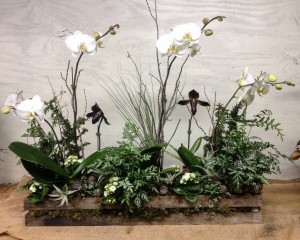
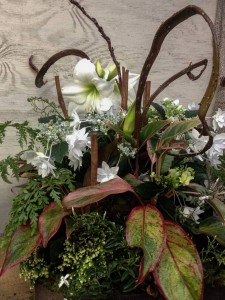
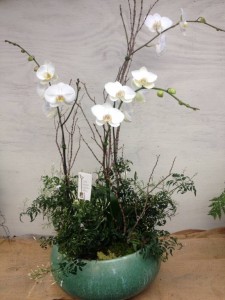
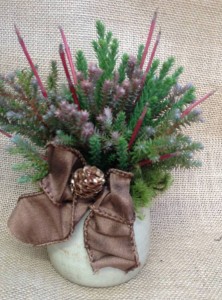
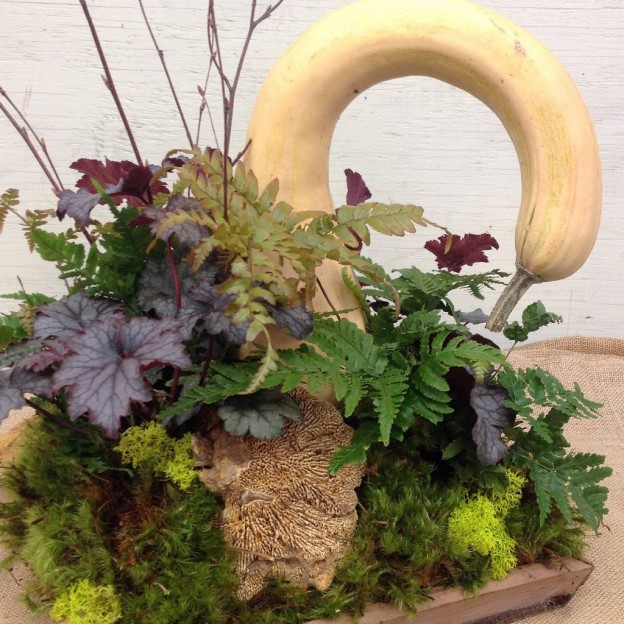
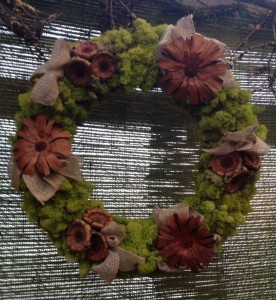
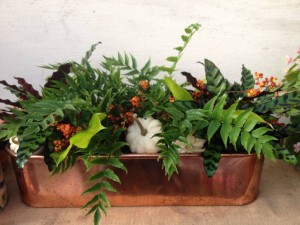
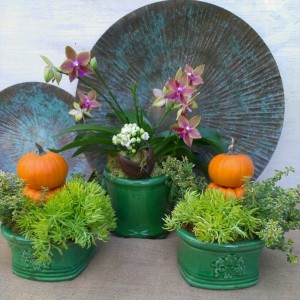
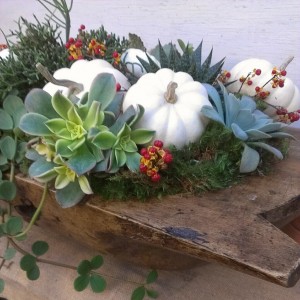
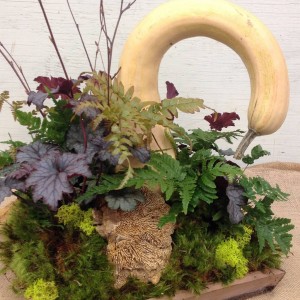
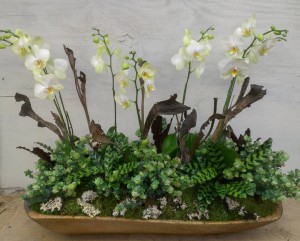
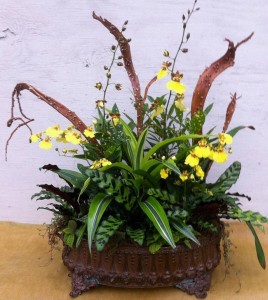
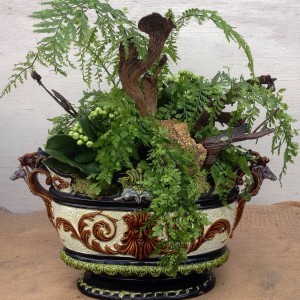
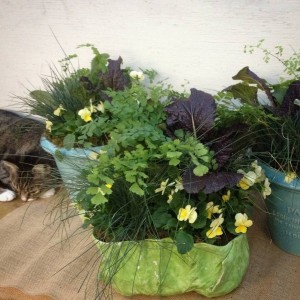
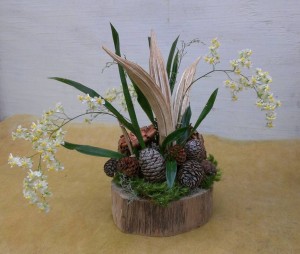
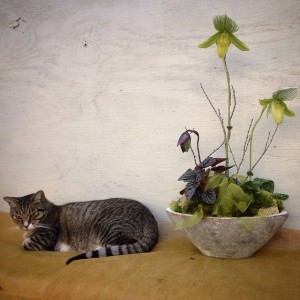
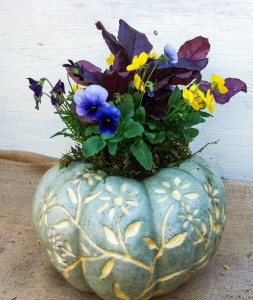
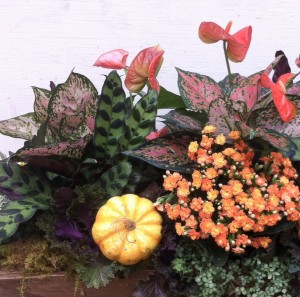
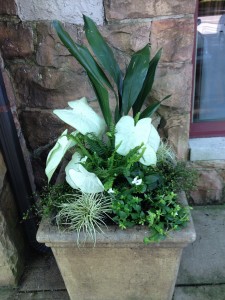 A testament to its common name of cast iron plant, the aspidistra looked amazingly good considering the bone-chilling temperatures Birmingham dipped to in January. It only needed a few leaves cut out, and no thinning was required this season…probably due to the cold. A heuchera, that had been added in the
A testament to its common name of cast iron plant, the aspidistra looked amazingly good considering the bone-chilling temperatures Birmingham dipped to in January. It only needed a few leaves cut out, and no thinning was required this season…probably due to the cold. A heuchera, that had been added in the 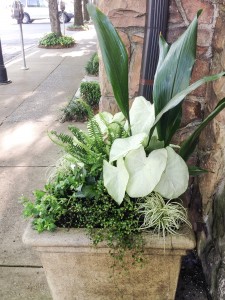 Torenia is an interesting plant, useful in
Torenia is an interesting plant, useful in 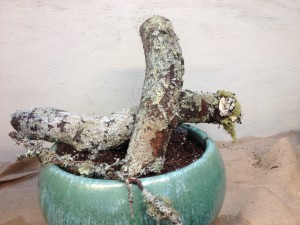
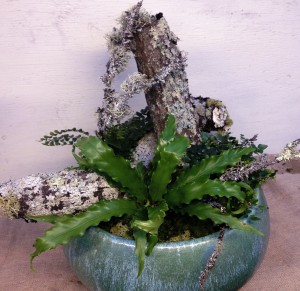
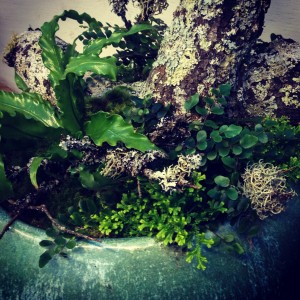
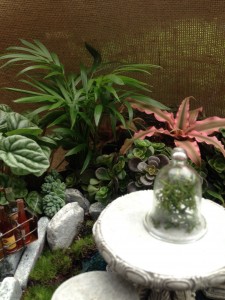
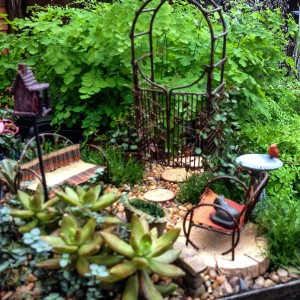
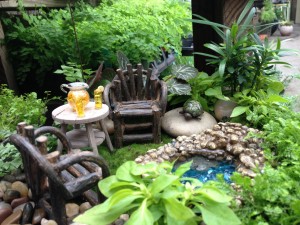
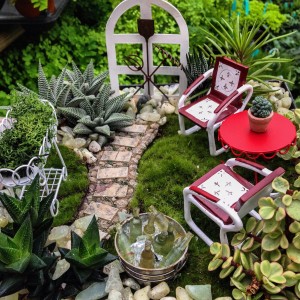 What does all this have to do with miniature gardens, you ask? Well, these tiny gardens have been very popular the past number of years, and the garden club organizers decided it would be a fun thing to have on some of the tables for one of their meetings. And they turned to Oak Street Garden Shop for help.
What does all this have to do with miniature gardens, you ask? Well, these tiny gardens have been very popular the past number of years, and the garden club organizers decided it would be a fun thing to have on some of the tables for one of their meetings. And they turned to Oak Street Garden Shop for help.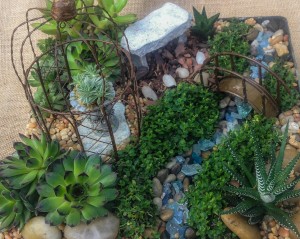 Because these take a great deal of time to make, I finally gave up on waiting for new miniature garden accessories I’d ordered since my deadline to have them completed was looming…but I still had plenty of fun things to play with. If you’ve ever made one of these
Because these take a great deal of time to make, I finally gave up on waiting for new miniature garden accessories I’d ordered since my deadline to have them completed was looming…but I still had plenty of fun things to play with. If you’ve ever made one of these 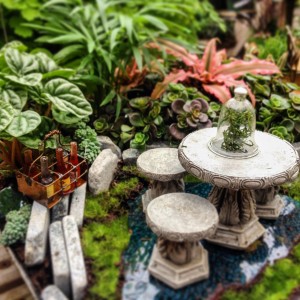 Tiny pots of ordinary houseplants also work in these gardens. Little parlor palms, ferns, polka dot plants and baby podocarpus make good companions, and selaginella is a pretty groundcover.
Tiny pots of ordinary houseplants also work in these gardens. Little parlor palms, ferns, polka dot plants and baby podocarpus make good companions, and selaginella is a pretty groundcover.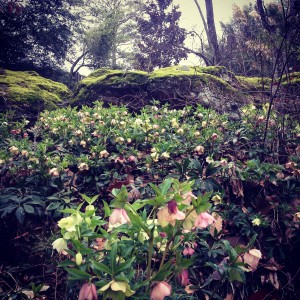
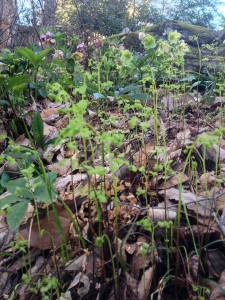
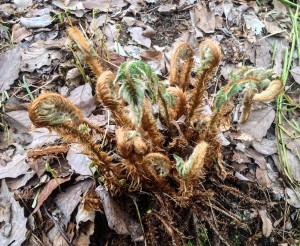
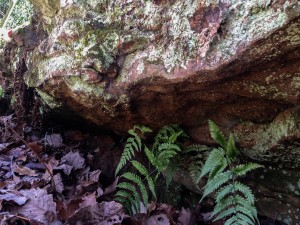
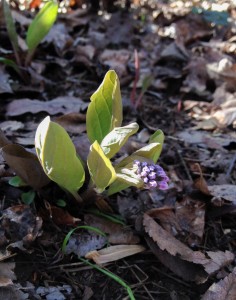
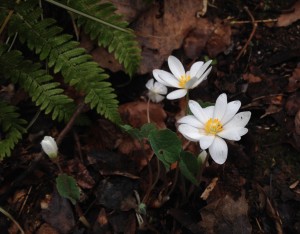
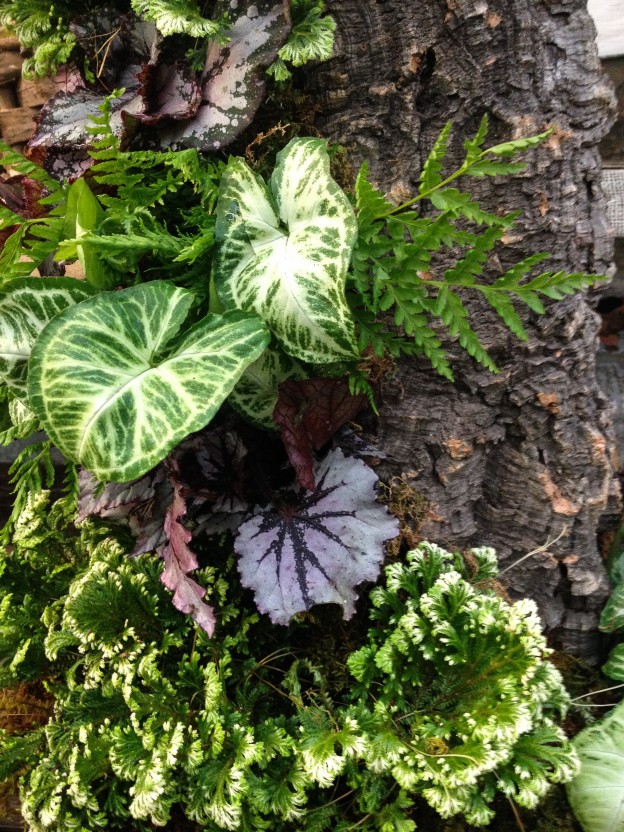
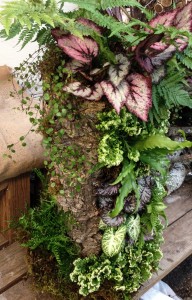 These pieces can be used either horizontally, planting along the top, or vertically, like I’ve designed this one, positioning the plants up the planter. Since it could be unsteady if it didn’t have something to stabilize it at the base, I placed it in a pulp planter that I’d covered with a layer of sheet moss. A plastic saucer underneath will protect the floor during its time indoors, then it can be used without the saucer out in the garden or on a patio, porch or other spot that has some shade.
These pieces can be used either horizontally, planting along the top, or vertically, like I’ve designed this one, positioning the plants up the planter. Since it could be unsteady if it didn’t have something to stabilize it at the base, I placed it in a pulp planter that I’d covered with a layer of sheet moss. A plastic saucer underneath will protect the floor during its time indoors, then it can be used without the saucer out in the garden or on a patio, porch or other spot that has some shade.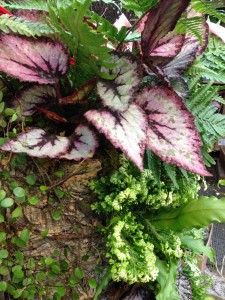 This planting has a variety of houseplants, including nephthytis, used for its lighter green and white foliage, rex begonias for a bit of color, tooth brake ferns and a bird’s nest fern, a new selaginella with white tips called ‘Frosty’, and a large autumn fern in the top with angel vine spilling over the edge with one last, large rex begonia.
This planting has a variety of houseplants, including nephthytis, used for its lighter green and white foliage, rex begonias for a bit of color, tooth brake ferns and a bird’s nest fern, a new selaginella with white tips called ‘Frosty’, and a large autumn fern in the top with angel vine spilling over the edge with one last, large rex begonia.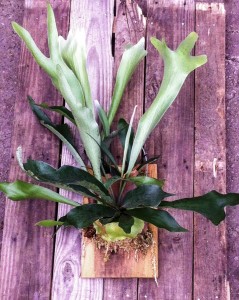
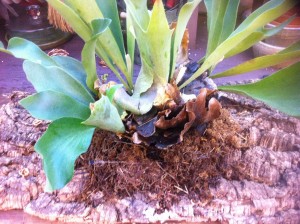
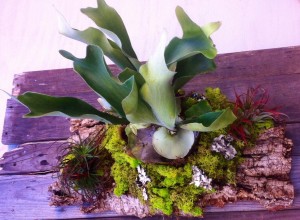
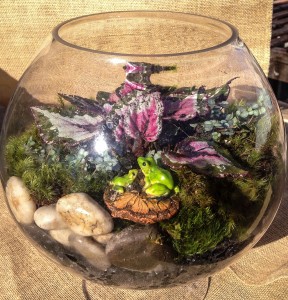
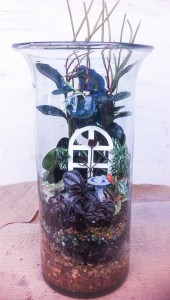
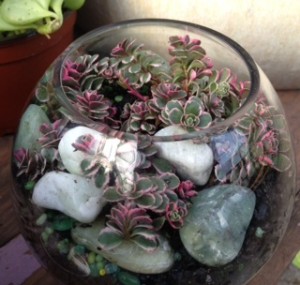
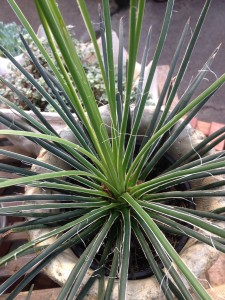
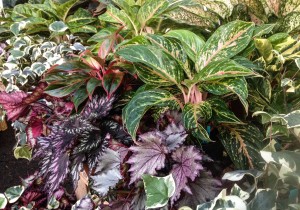
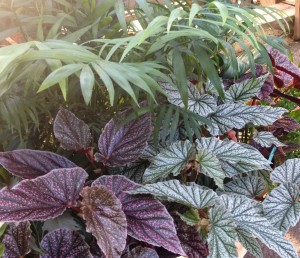
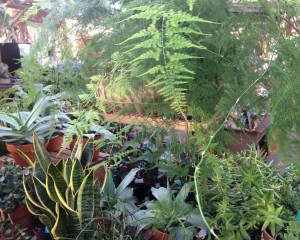
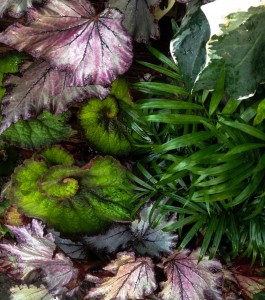
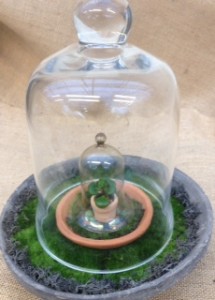 If you haven’t noticed,
If you haven’t noticed, 

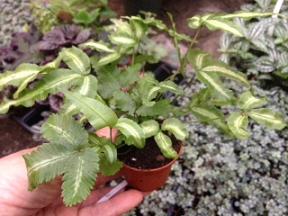
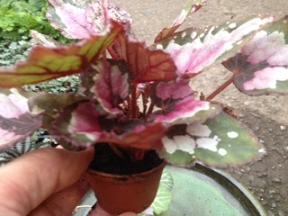


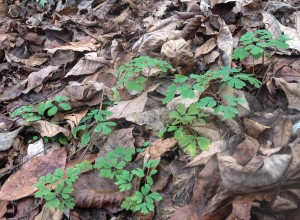
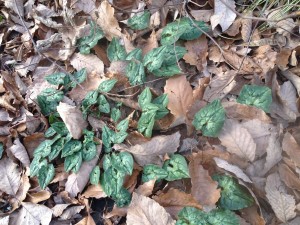
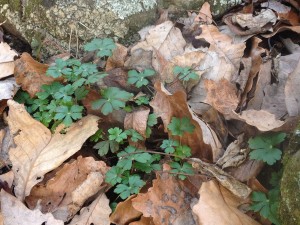
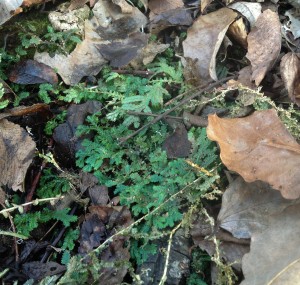
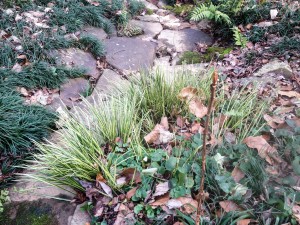
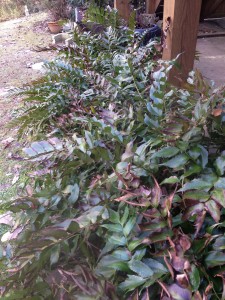
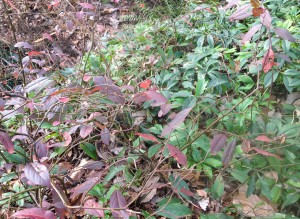 Above the water but spreading down the slope toward it, is a planting of Virginia sweetspire, Itea virginica ‘Henry’s Garnet’ , still holding the garnet colored fall foliage of its name. Underneath this spreading, suckering, shrub is another common evergreen perennial groundcover, the reliable Lenten roses, helleborus orientalis.
Above the water but spreading down the slope toward it, is a planting of Virginia sweetspire, Itea virginica ‘Henry’s Garnet’ , still holding the garnet colored fall foliage of its name. Underneath this spreading, suckering, shrub is another common evergreen perennial groundcover, the reliable Lenten roses, helleborus orientalis.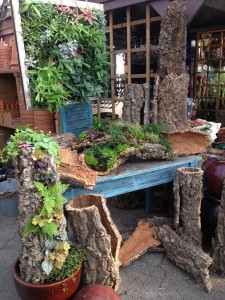
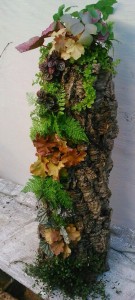
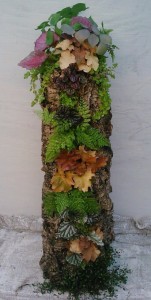 The tall one that Jamie planted utilizes houseplants which work very well in shaded areas through the summer, and some perennials. This piece will take filtered sun and clipping of the houseplants to maintain the balance of the planting. A pot was inserted in the bottom, planted, and then soil filled to the top, filling the opening all the way up to create a cool vertical piece.
The tall one that Jamie planted utilizes houseplants which work very well in shaded areas through the summer, and some perennials. This piece will take filtered sun and clipping of the houseplants to maintain the balance of the planting. A pot was inserted in the bottom, planted, and then soil filled to the top, filling the opening all the way up to create a cool vertical piece.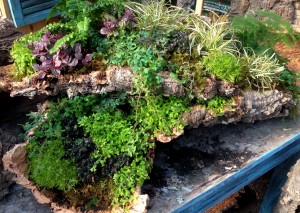 In the next planting, I took 3 of the flatter, rounded pieces and actually “stacked” them at angles, creating planting pockets and different levels and an overall shape I was pleased with. Next, perennials, including tassel ferns, ‘Metallica’ and ‘Burgundy Glow’ ajuga, golden and peacock selaginellas, Scotch moss and Carex ‘Evergold’, were added, creating sweeps of color and wispy trailers over the edges. An added bonus is that all of these plants are perennial and can be used in your landscape as they outgrow the container.
In the next planting, I took 3 of the flatter, rounded pieces and actually “stacked” them at angles, creating planting pockets and different levels and an overall shape I was pleased with. Next, perennials, including tassel ferns, ‘Metallica’ and ‘Burgundy Glow’ ajuga, golden and peacock selaginellas, Scotch moss and Carex ‘Evergold’, were added, creating sweeps of color and wispy trailers over the edges. An added bonus is that all of these plants are perennial and can be used in your landscape as they outgrow the container.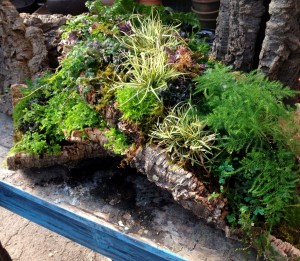 Both of these have been lined before planting but will drain over the edges in the case of the stacked pieces and down through the bottom of the planting in the tall piece. We picture them in areas of restful shade, adding their green presence to woodland surroundings…We hope you enjoy our creations as much as we enjoyed making them!
Both of these have been lined before planting but will drain over the edges in the case of the stacked pieces and down through the bottom of the planting in the tall piece. We picture them in areas of restful shade, adding their green presence to woodland surroundings…We hope you enjoy our creations as much as we enjoyed making them!